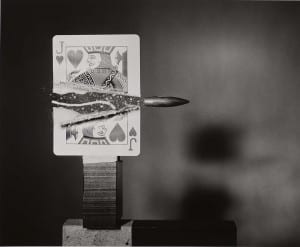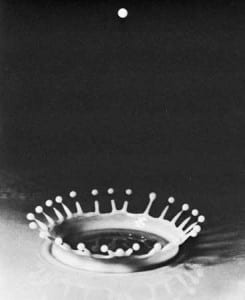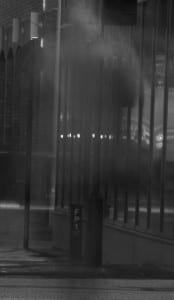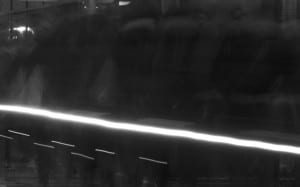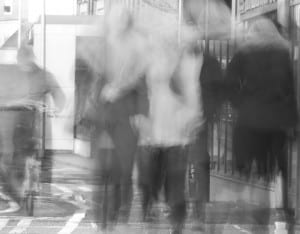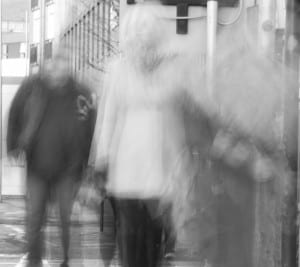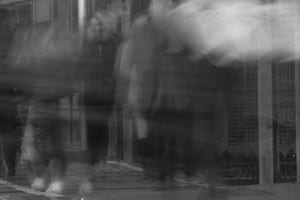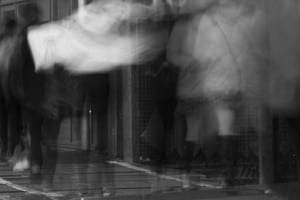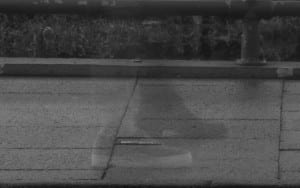Concept
These images are from the train track barriers near the university of Lincoln campus to represent the word ‘synchronicity’. I wanted to represent the people of Lincoln within my photographs, by using long exposure photographs but not too long that it takes away people’s identity.
My idea was to photograph people by the train tracks as the barriers come up to represent how everyone knows the semantics of when barriers go down at train tracks people know to wait and when the lift up the surge of people represents everyone knowing to go. This links into my idea of synchronicity as everyone is doing the same motion at the same time, being shown by ghost-like images to show the movement of people.
At first I wanted to visit many locations around Lincoln town centre to represent and show many different people in different places. However, after doing my first practice shoot I decided to only photograph people by the train tracks as the motion of people is very fluid and strong and it also fits into my theme and idea.
Influences
My main influence for my work is the photographs by Alexey Titarenko, “city of shadows” 1991-1993, which were captured in the fall of the Soviet Union in Saint Petersburg. He creates fluid long exposure photographs representing people within their daily lives walking around. However it creates ghost-like imagery, almost like shadows, but you can still understand can see individual faces and personalities. This was to represent the sadness of the people around him and to express emotions of the public within his work. I saw people on the verge of insanity, in confusion: unattractively dressed men and women with eyes full of sorrow and desperation, tottering on their routine dreary routes with their last ounce of strength, in search of some food which could prolong their lives and the lives of their families. They looked like shadows, undernourished and worn out.
“I saw people on the verge of insanity, in confusion: unattractively dressed men and women with eyes full of sorrow and desperation, tottering on their routine dreary routes with their last ounce of strength, in search of some food which could prolong their lives and the lives of their families. They looked like shadows, undernourished and worn out.”
http://www.alexeytitarenko.com/#/cityofshadows/
Another main influences on my work was the work of Albanian-American photographer Gjon Mili, Professor Harold Eugene Edgerton and German photographer Michael Wesley with their work with long exposure and use of movement in their photographs. I spoke about their work on the ‘home’ section of my blog.
Harold Eugene Edgerton uses movement in a different way to other practitioners I have looked at as he captures key moments of movement but not in log exposure, but with a faster shutter speeds. This creates very complex images as they are very fast moments captured without blur. It was interesting looking at Harold Eugene Edgerton’s work as he brings a different concept to movement within some of his photographs. However, he also creates photos which include long exposure too so it was interesting comparing his work.
Bullet through Jack of hearts
Milk Drop Coronet
My idea of my photographs is to capture the notion of every day within the city of Lincoln. Therefore I feel like my photography project comes under the category of documentary photography in the way that I am not trying to represent people in a certain way, but instead highlight the equal-ness that is sometimes lost in society. Graham Clarke sums this up well in his book “The Photograph” pg145/146
“From its beginnings the photograph has been understood through its ability to record an objective image of events with an assumed veracity that painting and drawing could never claim with equal authority. The cliché that the camera cannot lie is, thus, part of a deep but misplaced notion of the camera’s veracity as an agent of recording.”
Alternatives
Reflection
I believe I have come up with an original response to the word ‘synchronicity’ as I have used techniques which are generally used to represent confusion and the opposite of synchronicity and what it represents. Knowing the context of the images they create in interesting story, representing many cultures and backgrounds of people. With my images, I feel like the first three are very successful in representing a constant flow of people. I like the use of movement within the two foot images and the image of the moving train as it creates different stories behind the images as you can see people behind the train on the other side of the tracks.
The first two images in the ‘Alternatives’ section of my blog are disappointing as if the were both brighter and more evenly lit they would make good images with a good use of movement and lighting in the second one. Furthermore they are confusing if the context is not understood whereas my final images can be appreciated context-free.
I decided to create my final images in black and white for multiple reasons: my main influence Alexey Titarenko who’s work is all in black and white. Furthermore, I simply prefer it looks wise, as it looks more uniform and highlights my idea of everyone being the same, doing the same thing, everything in synchronicity. If someone was wearing a bright red coat I feel it would take away from the concept of synchronicity and overall ruin my images.
Looking at all the images technically I think they are good, sound images, not over or under exposed and represent and reflect my idea well. My criticism of my final images are that they all different sizes as I formatted them afterwards to control my composition and make it more focussed. As I only have a short time to set up my camera between the barriers going down and them lifting again sometimes my composition is a little wide for the look I’m going for.
